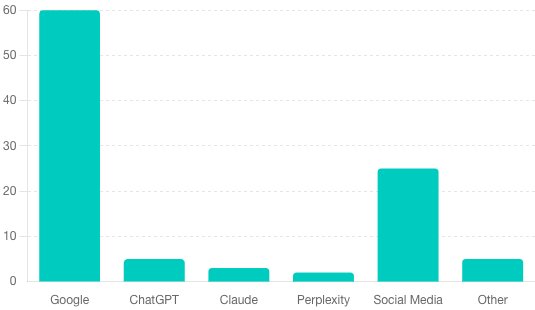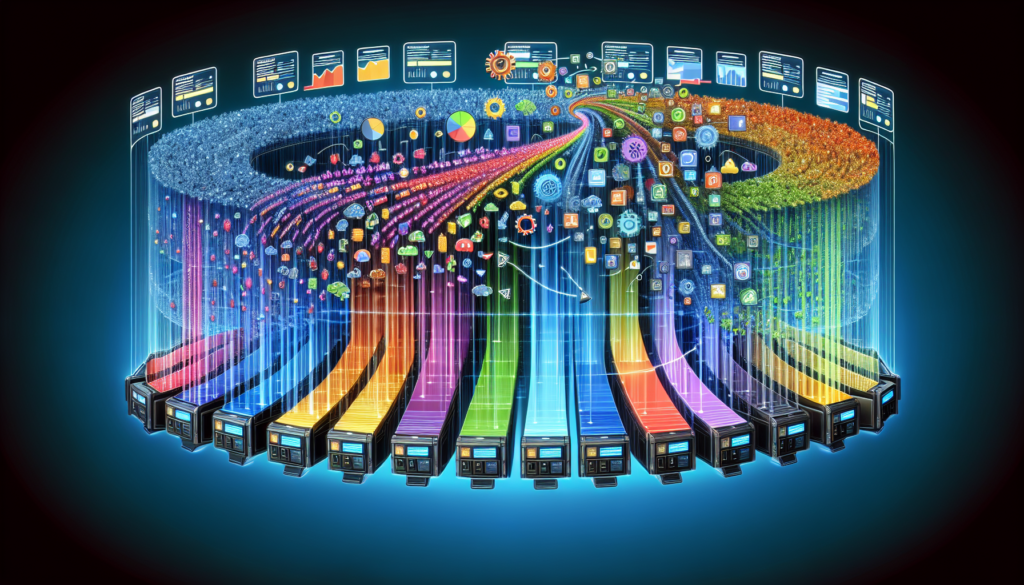
Updated August 10, 2024
Watching the Google Search Experience unfold in the last 3 months was like watching a slow train derailment. As late as march, I was convinced that Google could over come the search everthing habits of users, and strike the perfect balance between organic search, paid ads, and AI-generated content. However, they’re too preoccupied with the decline in their ad revenues to pay much attention to the people who were searching.
Today, the landscape of search has changed drastically. The options for conducting searches have multiplied from familiar names like Google, TikTok, FaceBook, Instagram, YouTube, and Pinterest to emerging platforms like Perplexity, ChatGPT, Claud, and more. This transformation in search capabilities is collectively known as Generative Search and the task of optimization for this group is called GSO or (you guessed it: Generative Search Optimization).

and SEO is still important
Search Everything Optimization (SEO) involves refining a website’s content, structure, interface, and overall online presence to maximize discoverability across all platforms. The goal is to enhance the website’s unpaid visibility in search results. As search behavior becomes more diverse and inclusive of platforms beyond Google, businesses must adapt by broadening their SEO strategies. What was once considered optional now forms an integral part of client recommendations. Effective SEO also impacts business processes by efficiently managing and monitoring machine learning models, minimizing risk, and understanding the impact of these models on decisions and operations within an organization.
To adapt to the rapidly changing world of web search, we must recognize the growing importance of optimization and prepare for the new SEO requirements. Central to this concept is understanding the fundamental unit of search—the search engines.
Search Everything & Traditional SEO
Traditional SEO focuses on aligning websites and content with the Google algorithm to meet its criteria for quality search results. However, the expansive nature of modern search emphasizes the need for a broader approach.
For over a decade, Google was the search engine of choice for 90% of people globally. So, SEO is about making sure your pages meet the criteria set by Google to rank webpages:
-
-
- Satisfy search intent (what the searcher is looking to achieve)
- Demonstrate experience, expertise, authoritativeness, and trustworthiness (E-E-A-T)
- Load quickly and perform well
- Are easily navigable by viewers and search engine
-
Some of the most common SEO tactics include:
-
-
- Key phrase research: Identifying and analyzing the search terms target audiences use
- Content creation: Creating quality content that meets your target audiences’ needs
- Structured data: Use of schema (structured data) to facilitate indexing of your website
- Link building: Getting other websites to link to your site so that it appears more trustworthy
- Technical SEO: Improving the technical performance of your site for potential clients and seo, including troubleshooting indexing issues
-
Traditional SEO remains vital because it improves your organic visibility in SERPs, and provides the basis for you to get a better visibility in Generative search result. Better visibility can translate to more brand awareness and website traffic, leading to more sales.
Why does traditional SEO process still matter
-
-
- Ranking high in SERPs is still important
High SERP rankings lead to increased website clicks and traffic. With billions of daily searches and over 43% of searchers clicking organic results, SEO is crucial for capturing available clicks in your niche and outperforming competitors. Understanding and implementing key practices is the most important part of indexing your website and achieving high search engine rankings. - SEO is cost-effective
SEO is cost-effective because it doesn’t involve advertising costs and can deliver long-term results. Once high rankings are achieved, they can be maintained with little effort, making SEO highly scalable and potentially leading to significant traffic growth. - Build brand awareness and trust through SEO.
Frequent and prominent appearances in search results help build brand awareness and trust. Even if viewers don’t click on your results, repeated exposure can establish your brand as authoritative and trustworthy, increasing the likelihood of future engagement. - Competitive analysis for better-qualified traffic
Competitive analysis helps businesses understand their potential organic traffic, reach, and how they compare to competitors in website search rankings. Competitive analysis provides valuable insights into traffic trends, keyword opportunities, and areas for improvement in SEO strategies. - SEO success supports other marketing efforts, such as PPC.
SEO success can enhance the results of other marketing efforts, including PPC campaigns. When users search for information after encountering marketing campaigns elsewhere, strong organic rankings ensure continued engagement. Combining SEO with PPC can provide the best of both worlds, maximizing exposure and click-through rates. - Your Key Phrases inform your content strategy.
Effective key phrases are one of the most productive ways of harmonizing your GSO and Social Media strategies with your traditional SEO. As we know, keyword research for traditional SEO can provide quality key phrases.
- Ranking high in SERPs is still important
-
Search Everything & Generative Search Optimization

Generative search optimization (GSO) is an emerging method focused on optimizing content and data to enhance the discoverability and relevance of generative AI models. With the ever-increasing use of generative AI (LLM) tools such as Claud, ChatGPT, or Perplexity, GSO can significantly drive Views and Conversions.
New features in ChatGPT, Claud, Gemini, and Perplexity can enhance GSO efforts by allowing potential clients to test and experiment with different variations, such as fonts, calls to action, headlines, product copy, and product placement, to determine their effectiveness.
It’s important to highlight that GSO represents a newer field in SEO. Achieving noticeable results in this area may take longer than traditional SEO. However, it’s still worth pursuing and staying updated on its progress.
Arpana Tiwari, former SEO director at Adobe and Eventbrite, advises B2B marketers to consider AI assistants like Claud, ChatGPT, Perplexity, and Gemini for search-based decision-making.
Here are some tips to improve visibility with Generative Search and Large Language Model algorithms:
-
-
- Wikipedia page writing: Creating a Wikipedia page for your brand can improve online authority, search engine rankings, and visibility within large language models such as Claud or ChatGPT. Wikipedia’s credibility and high domain authority help to build trust among your audience. Moreover, Wikipedia serves as a crucial data source for large language models, and having a page ensures accuracy and increases the frequency of your brand getting referenced. Overall, it enhances credibility, visibility, and authority.
- Digital PR and brand mention campaigns: If you’ve ever asked ChatGPT to recommend a list of stores or brands, you’ve probably noticed that you’re presented with well-known brands. Whether you ask for the best toddler pajama brand, the best SEO agency, or where to buy a microwave, you’ll likely get a list of criteria, including reputation, recognition, popularity, and reliability. Leverage digital PR, an incredibly impactful umbrella of PR tactics, to boost your online authority and strengthen your chances of being favorably recommended for relevant prompts.
-
Generative Search Optimization Best Practices
-
-
- Use structured data and schema markup to organize your data as part of the GSO process.
- Identify and incorporate relevant statistics, quotations, and citations to add value to your content.
- Build authority on specific topics by creating comprehensive content clusters that cover the entire customer journey.
- Use natural and contextually relevant language to make your content more valuable.
- Include diverse content formats like images, videos, and GIFs to make your content engaging.
- Implement internal and external contextual linking to improve the user experience and SEO.
- The regular content update ensures relevance and makes it more valuable to your audience.
-
Search Everything & Social Search Optimization
Did you know that more and more people are using social media for their online searches? According to Google, around 40% of young folks prefer using apps like TikTok and Instagram to look for stuff instead of using regular search engines. They want to find quick and visual answers. Also, people share videos with their friends twice as much as any other type of content.
Videos are great for helping people understand products and services better and for making brands more well-known. After watching an Instagram story, about 58% of Instagram users feel more connected to a brand. While optimizing for multiple social platforms can be time consuming, it is essential for maximizing visibility and engagement. You might be missing out if you’re not considering social platforms as search engines in 2024 and beyond. Here’s a detailed look at how people might use their favorite apps and how you can make sure your stuff gets seen by more people.
TikTok
TikTok’s impact on search behavior has not gone unnoticed by savvy SEO professionals. The content people encounter on TikTok often prompts them to conduct further searches on Google. With the recent launch of TikTok Shop, younger audiences are turning to TikTok to discover and purchase products, signaling a potential for substantial conversion rates.
Optimizing content is essential to improved visibility and engagement on TikTok. We want to appear among the first 8-16 videos when people search for key terms or hashtags related to our products. To achieve this, we need to work with creators, provide them with top keywords and hashtags, and strategically use these in our content.
Organizing your content into folders can help improve visibility and engagement on TikTok. This method allows for better categorization and easier access to relevant videos, enhancing the user experience.
TikTok is changing the way people search for things. Certain products become popular on the app, and new search terms come from phrases used in videos. Popular phrases can lead to more visibility and sales naturally or through partnerships with influencers.
TikTok users often turn to Amazon or search engines before purchasing. Since TikTok is relatively new to e-commerce, customers usually do additional research on Google. They may buy through trusted channels like Amazon or a brand’s direct site.
To maximize brand visibility, having the right content on TikTok and following search demand and SERP trends is crucial. We can also embed successful TikTok videos on our site to increase engagement, which can significantly impact our visibility on Google.
When considering launching TikTok marketing campaigns, it’s crucial to understand that traditional content could perform more effectively on this platform. TikTok’s culture is distinct from other social platforms, and brands must be adaptable and stay current. Your audience expects you to be genuine, unfiltered, trendsetting, entertaining, and informative.
In today’s digital landscape, more people turn to videos for learning. Viewers seek quick, informative content, and influencers can create material that truly resonates with their audience. These qualities are why short-form videos are so successful. Compared to other formats, short-form videos can:
-
-
- Boost engagement and broaden your reach through social algorithms.
- Establish your company as an innovator and expert within your industry.
- Increase brand awareness by creating more PR opportunities.
- Provide the flexibility to repurpose content for all social media channels, including YouTube Shorts, TikTok, and Instagram Reels.
-
Optimizing content on TikTok requires a different approach than optimizing for Google. Keyword stuffing is not effective on TikTok. To optimize effectively, brands and content creators should:
-
-
- Incorporate keywords into the audio.
- Utilize keywords in text overlays.
- Include keywords in the audio transcription.
- Use keywords in the video caption.
- Utilize keywords as hashtags.
-
Your TikTok optimization strategy is similar to your plan for significant search engines. Maintaining a balance between SEO and brand image is crucial. Overusing keywords could have a negative impact, so it’s essential to use them strategically. However, the current approach is practical; if it still needs to be fixed, there’s no need to fix it.
Are you trying to get lots of views on your short videos? Here are some tips that could help.
First, think about what you’re talking about in your video. It could get more views if it’s popular or if it might get people talking.
Another thing to consider is starting your video with something attention-grabbing to keep people watching. For example, you could say, “I did nothing but this viral push-up machine for 100 days, and it changed my life…”
If you prefer to avoid controversial topics, using popular sounds or music in your videos might attract more viewers. Just ensure you’re following the rules about using other people’s music.
You could add subtitles, extra footage, animations, and sound effects to attract more viewers or combine your videos with popular ones.
And remember, even though TikTok is popular, platforms like Facebook and Instagram are still important. Let’s look at ways to make your content work well on these platforms owned by Meta.
Facebook and Instagram
Are you interested in using Meta’s social media platforms to connect with a younger audience? Here are some tips to help you improve your content performance:
-
-
- Understand your audience: Before anything else, get to know who you’re trying to reach. Find out what your audiences like and what issues they care about. You can use social listening tools to research popular topics and hashtags that interest you.
-
Managing and optimizing image and video files is crucial for better performance on Facebook and Instagram.
-
-
- Take advantage of trends: To make your content more visible, try including hot topics, but stay true to your brand and avoid copying others’ ideas.
- Write captivating captions: Your captions should be clear, concise, and attention-grabbing. Include relevant keywords naturally in your text.
- Use hashtags: Research relevant hashtags to categorize your content and make it more discoverable.
- Optimize for voice search: Consider using natural language in your captions to make them more conversational.
- Collaborate with influencers: Influencers boost your brand’s visibility, secure media coverage, provide keyword insights, and enhance your website’s content.
- Plan your content: Develop a diverse content calendar with images, videos, stories, and live streams to keep your audience engaged.
- Embrace video: Video content is essential on social media, so use tools like Facebook and Instagram Reels, IGTV, and Facebook Live to create engaging videos.
- Focus on quality: Invest in good lighting, sound, and editing to create good videos while keeping them real. A decent-quality video with human attributes will capture your audience’s attention.
- Optimize for mobile: Since most social media is consumed on mobile devices, make sure your videos are captivating on smaller screens and consider filming vertically.
-
YouTube
Understanding and implementing YouTube SEO best practices is essential for improving video visibility and reaching a broader audience. Optimizing for YouTube can also positively impact Google visibility, with video content often prominently featured in search results. This optimization can drive additional traffic and engagement. Compelling video content can also serve as a customer acquisition and engagement tool. Repurposing video content into other formats can enhance overall marketing strategy and create a seamless user journey.
Using video editing software is crucial in creating high-quality YouTube content that stands out and engages viewers.
While traditional keyword optimization remains important, YouTube’s algorithm now emphasizes audience engagement metrics. Thus, engaging videos that maintain viewer interest from start to finish is crucial. Strategies include:
-
-
- Capturing attention early.
- Structuring videos for optimal watch time.
- Utilizing end screens and cards to promote related content.
-
Beyond content creation, conducting a video content gap analysis can help ensure a data-driven video production strategy. Understanding what’s trending in a given niche and identifying highly searched keywords can inform video ideas and optimize content for search discovery. Optimizing video tags, conducting channel audits, and focusing on storytelling and production value can enhance video performance.
In terms of content itself, strategic titling, crafting compelling yet concise video descriptions, and using relevant hashtags can improve video discoverability. Furthermore, making behind-the-scenes technical SEO adjustments by adding captions, choosing appropriate video categories, and creating custom thumbnails can improve performance.
Pinterest is a compelling platform, especially with its increasing focus on e-commerce. It boosts brand awareness, attracts traffic, and drives sales. Let’s take a closer look at the latest techniques to enhance your presence on Pinterest for maximum impact:
-
-
- Keyword Research is Essential: Conduct thorough keyword research to identify the most relevant terms people use when searching for products or inspiration within your niche.
- Optimize Titles and Descriptions: Naturally, incorporate your target key phrases into your pin titles and descriptions. Maintain readability and entice viewers to click on your pins.
- Descriptive Board Names: Choose clear and concise board names that include relevant keywords, making it easier for potential clients to discover your content.
- Alt Text Matters: When creating pins, pay attention to the importance of adding alt text descriptions. Including relevant keywords can significantly improve the visibility of your pins in search results.
- Focus on High-Resolution Visuals: Since people visit Pinterest for visually appealing content, using high-quality images, ideally with a 2:3 aspect ratio, is crucial. Clear, well-lit, and eye-catching visuals will attract more attention.
- Optimize Image Files: Optimized image files provide better visibility on Pinterest. Ensure your images are properly named and optimized without losing quality for optimized load times and improved search process.
-
FAQ
Q: What is Search Everything Optimization (SEO), and how does it differ from traditional SEO?
A: Search Everything Optimization (SEO) is a broader approach to optimizing a website’s content, structure, and online presence for discoverability across all platforms, not just Google. It includes traditional SEO practices but extends to optimization for social media, video platforms, and AI-powered search process.
Q: What is Generative Search Optimization (GSO), and why is it important?
A: Generative Search Optimization (GSO) is an emerging method focused on optimizing content for generative AI models like ChatGPT, Claude, and Perplexity. It’s crucial because these AI tools are increasingly used for search and information gathering, potentially driving views and conversions.
Q: How is TikTok changing search behavior, and how can businesses optimize for it?
A: TikTok is becoming a popular search platform, especially among younger users. Businesses can optimize for TikTok by incorporating keywords into video audio, captions, and hashtags, creating engaging short-form video content, and staying current with trends and popular phrases on the platform.
Q: What are some critical strategies for optimizing content on social media platforms?
A: Key strategies include understanding your audience, leveraging trends, writing captivating captions, using relevant hashtags, optimizing for voice search, collaborating with influencers, creating diverse content, including video, and ensuring high-quality production.
Q: How can businesses improve their visibility in YouTube searches?
A: To improve YouTube visibility, businesses should focus on creating engaging content, optimizing video titles and descriptions, using appropriate tags and categories, creating custom thumbnails, and conducting video content gap analysis to inform their content strategy.
Q: Why is Pinterest important for e-commerce, and how can businesses optimize their presence on the platform?
A: Pinterest is increasingly focused on e-commerce, making it valuable for brand awareness, traffic, and sales. Businesses can optimize their Pinterest presence by conducting keyword research, optimizing pin titles and descriptions, using high-quality visuals, creating video pins, and optimizing their “About” page with relevant keywords and a clear value proposition.
Conclusion
As we navigate the changes in search and optimization, it’s clear that the traditional SEO practices we’ve relied on for years remain crucial. However, emerging new search platforms and technologies demand a more comprehensive approach. Search Everything Optimization (SEO) is no longer just about Google; it now encompasses many platforms, including social media, video-sharing sites, and AI-powered search tools.
The key to success in this new era lies in adaptability and diversification. While maintaining solid traditional SEO practices, businesses must also embrace Generative Search Optimization (GSO) and Social Search Optimization. The new SEO means optimizing content for AI models, leveraging platforms like TikTok and Instagram for search visibility, and continuing to create high-quality, engaging content across all channels.
A holistic optimization approach is essential as search behavior becomes increasingly fragmented across various platforms. This includes understanding each platform’s unique characteristics and requirements, from TikTok’s short-form video content to Pinterest’s visual discovery engine.
Efficient indexing is crucial in achieving successful search optimization across multiple platforms. Ensuring that new content is quickly and accurately indexed can significantly enhance visibility and engagement.
Ultimately, the goal remains to increase visibility, engage audiences, and drive conversions. However, the methods to achieve this goal have expanded. By staying informed about emerging trends, continuously adapting strategies, and maintaining a presence across multiple search platforms, businesses can remain discoverable and relevant in the age of Search Everything Optimization.
Searching everything, everywhere, is, by definition, dynamic and multifaceted. Those who can effectively balance traditional SEO with new forms of optimization will thrive in the ever-changing digital landscape.
Dream Warrior Group, a Los Angeles-based web design and digital marketing Company, provides solutions for your online marketing needs. Our expertise includes Search Engine Optimization (SEO), Social Media Posts and marketing, and Google PPC campaigns. Call us now at 818.610.3316 or click here.












